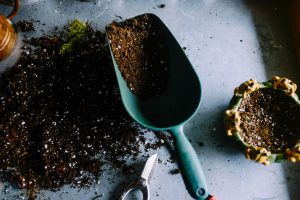Think it’s time to re-pot a plant but not sure where to start? Here’s what you need to know about repotting your houseplants!
When to Repot your Houseplant
Re-potting your plant into the same container works wonders by refreshing the soil and freeing up root space. Potting up should only be done when your plant has become root bound or overcrowded in its container.
Repotting does not necessarily mean changing a plant’s pot, but rather, it could mean just changing its soil. Fresh soil means new nutrients and that’s what will keep your houseplants happy. The great news is that it’s not hard to do and your houseplants will thank you for it.
If you’re thinking about moving your plant into a larger planter, or “potting up”, this should be done when your plant has become root bound or overcrowded in its container. A good rule of thumb is to go up 1-2 inches in diameter to provide room for continued growth.
If you see one or a combination of these signs, you’ll know it’s time to repot:
- The plant simply looks like it is too big for its pot
- The roots are growing out of the drainage holes
- Water is sitting on the top and not absorbing
- The soil is dried out or looks like it is disintegrating
- It’s been years since you repotted it

Plants typically need to be repotted every 12 to 18 months, depending on how actively they’re growing. Some plants can stay in the same pot for years, but they definitely will need a soil replenishment.
The absolute best time to re-pot your plants is early spring–right before the start of the growth season. But if you notice your plant is root bound, don’t wait for spring to give your plant a larger place to call home.
What you need to re-pot:
- New pot – Be sure to pick a new pot that is slightly larger and has drainage holes.
- Potting mix – You will need extra soil when repotting and the added nutrients will help your plant grow.
- Gloves (not necessary) – in case you want to avoid dirt from getting under your nails.
- Scissors or a sharp knife – You might need to cut off excess roots so keep a sharp knife or scissors handy.
- Watering can – While this isn’t necessary, a watering can will make watering the plant easier on you.
HOW TO RE-POT INDOOR PLANTS
- Water your plant thoroughly 1-2 days before you plan to re-pot. This will make it easier to get your plant out of its pot, and hydration will reduce the risk of shocking your plant.
- Turn your plant sideways or upside down while placing your hand over the top of the pot. Rotate the plant a few inches in both directions to loosen it up and allow it to fall out. Be gentle, but sometimes your plant might need a little help coming out.
- Tease and prune the roots. Removing older roots will help the plant flourish in its new pot. After pruning, gently untangle the remaining roots so they grow outwardly instead of inward.
- Remove about 1/3 of the old potting mix.
- We recommend using pots that have drainage holes. But if yours doesn’t, line the bottom of the pot with small stones, to allow for proper drainage-making it less likely you will accidentally overwater and kill your plant!
- Pour fresh potting mix into your planter, filling it about ⅓ of the way full.
- Place your plant in the new pot and fill in with soil until all roots are covered and air. Press soil gently to ensure that there are no air pockets, but take care not to crush delicate roots.
- Water lightly so that the new soil is barely moist.
- After repotting, plants tend to enter a period of shock. Be patient–it’s normal. Water frequently during this time as your plant will need a little extra water as it adjusts. The roots may begin to grow and will need the extra moisture. It’s also important to make sure your plant doesn’t receive too much sunlight during this sensitive period. And hold off on fertilizing for about a month!

Follow these tips and you’ll be on your way to re-potting like a pro! As a friendly reminder, if you have a plant that already seems stressed, hold off on repotting! For example, a thirsty plant may not survive the repotting process. Nurse your plant back to health and THEN re-pot.
Don’t forget to join the plant family for weekly tips on caring for your houseplants straight in your inbox! Sign-up here! Happy repotting!